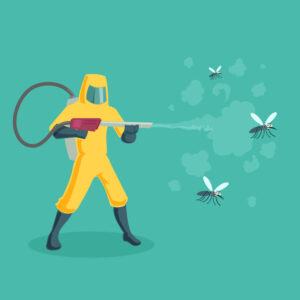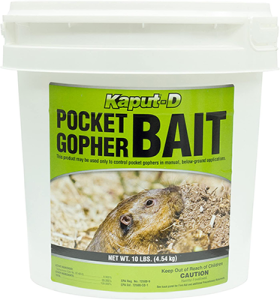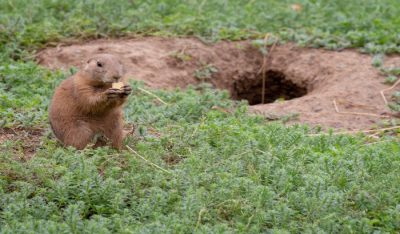Discovering gopher activity in your yard can be frustrating. These burrowing rodents can quickly transform a beautiful landscape into a network of tunnels, mounds, and damaged plants. While gophers play an important role in natural ecosystems, their presence in gardens, lawns, and agricultural areas often requires intervention. This comprehensive guide explores how to get rid of gophers – from simple deterrents to more intensive solutions, helping you choose the approach that best fits your situation.
Effective gopher management typically follows a progressive approach: first identifying the problem correctly, then implementing prevention strategies, followed by non-lethal repellent and exclusion methods, and only considering trapping or more intensive control measures when necessary. This guide will walk you through each approach, allowing you to choose the least invasive solution that works for your specific situation.
- Identifying Gophers: Know Your Underground Pest
- Understanding Gopher Behavior
- Control Strategy 1: Prevention and Natural Deterrents
- Control Strategy 2: Physical Exclusion Methods
- Control Strategy 3: Trapping Methods
- Control Strategy 4: Fumigation and Carbon Monoxide
- Control Strategy 5: Baiting with Rodenticides
- Professional Gopher Control Services
- Creating an Integrated Gopher Management Plan
- Frequently Asked Questions
- How to Get Rid of Gophers: Conclusion
Identifying Gophers: Know Your Underground Pest
Before implementing any control strategy, it’s essential to confirm you’re dealing with gophers rather than moles, voles, or other burrowing animals. Each requires different management approaches.
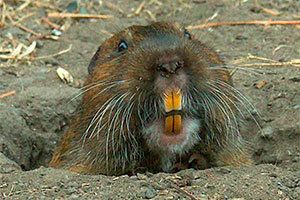
Gopher Characteristics
- Medium-sized rodent (6-8 inches long)
- Fur-lined cheek pouches for storing food
- Small eyes and ears, large front teeth
- Brown to grayish fur that matches soil
- Short, stubby tail (1-2 inches)
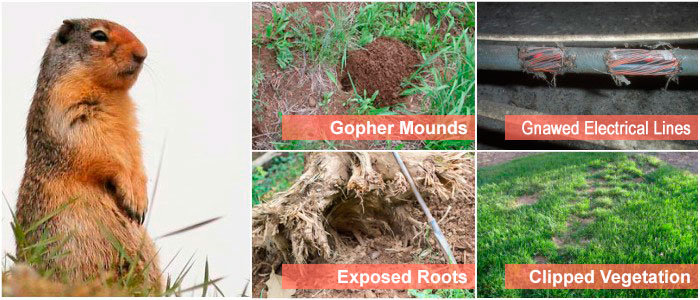
Gopher Signs
- Fan or crescent-shaped soil mounds
- Plugged entrance holes
- Multiple mounds in a line pattern
- Plants pulled underground
- Gnawed roots and underground damage

Gopher Damage
- Underground consumption of roots and bulbs
- Trees and plants wilting without cause
- Damage to irrigation systems
- Undermined walkways or foundations
- Risk to underground utility lines
If the signs you’re seeing don’t match gopher activity, you might be dealing with a different pest. Moles create volcano-shaped mounds and primarily eat insects, not plants. Voles create surface runways through grass but rarely build mounds. Ground squirrels and prairie dogs create mounds but spend most of their time above ground. Identifying the correct pest is crucial for effective control.
Understanding Gopher Behavior
| Behavior | Description | Control Implications |
|---|---|---|
| Habitat Preference | Prefer loose, moist soil with abundant vegetation | Modifying soil conditions can deter settlement |
| Tunneling Patterns | Main tunnels 4-18 inches deep; nest chambers up to 6 feet deep | Deeper control methods needed for established systems |
| Territory Size | Single gopher can occupy 200-2,000 sq ft area | Treatment area must encompass entire territory |
| Social Structure | Primarily solitary except during breeding season | Individual control usually sufficient, but recolonization common |
| Diet | Herbivorous: roots, bulbs, tubers, and occasional surface vegetation | Plants with unpalatable roots can deter feeding |
| Activity Patterns | Active year-round; peak activity in spring and fall | Control most effective during high activity periods |
| Reproduction | 1-3 litters annually, 5-6 young per litter | Persistent control needed to prevent population growth |
Control Strategy 1: Prevention and Natural Deterrents
The first line of defense against gophers is creating an environment that’s less hospitable to them. These preventive measures are non-lethal, environmentally friendly, and often effective for minor infestations or newly established gopher populations.
Gopher-Resistant Planting
Incorporate plants that gophers hate throughout your landscape. Gophers tend to avoid plants with strong smells or textures, including:
- Aromatic herbs (lavender, rosemary, sage)
- Euphorbia species (gopher purge)
- Alliums (garlic, onions, ornamental alliums)
- Marigolds and geraniums
- Daffodils and other narcissus varieties
Natural Repellents
Several natural substances can make your yard less appealing to gophers:
- Castor oil: Mix 2 tablespoons with 1 tablespoon of dish soap in a gallon of water. Apply to soil near active tunnels.
- Peppermint oil: Create a spray with 10-15 drops in water with a drop of dish soap. Apply around plants and near tunnel entrances.
- Used coffee grounds: Sprinkle throughout your garden or directly into tunnels.
- Fish emulsion: While effective, use cautiously as it may attract other animals.
Sensory Deterrents
Devices that create vibration, sound, or water disturbances may discourage gophers:
- Solar ultrasonic stakes: These emit vibrations that may irritate gophers.
- Windmills and pinwheels: Create ground vibrations that can deter settlement.
- Flood irrigation: Where possible, periodic flooding can discourage gophers.
- Note: Effectiveness varies and habituation may occur over time.
Attracting natural gopher predators can help keep populations in check. Install barn owl nesting boxes (a barn owl family can consume up to 1,000 gophers annually), create perches for hawks and eagles, and maintain habitat for snakes, coyotes, and bobcats where appropriate. While predators alone may not eliminate an established infestation, they can help prevent future problems.
Control Strategy 2: Physical Exclusion Methods
Physical barriers can provide long-term protection for valuable plants and specific areas. While these methods require initial effort and investment, they offer a sustainable, non-toxic approach to gopher management.

Underground Fencing
- Dig trench 24+ inches deep around area
- Install 1/4 to 1/2-inch hardware cloth
- Bend bottom 6 inches outward at 90°
- Extend 4-6 inches above ground level
- Best for protecting defined areas
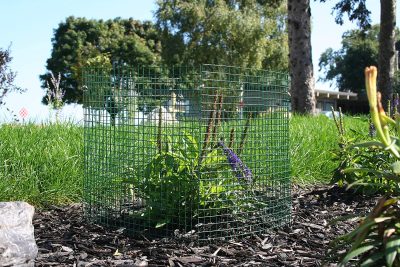
Plant Protection Baskets
- Create baskets from 1/2-inch hardware cloth
- Size appropriately for root ball plus growth
- Place in planting hole before installing plant
- Ideal for protecting individual trees and shrubs
- Allows roots to eventually grow through mesh

Raised Bed Barriers
- Line bottom of raised beds with hardware cloth
- Extend mesh 6+ inches up sides
- Use 1/4 to 1/2-inch mesh size
- Protects vegetable gardens and flower beds
- Prevents gophers from accessing plants from below
Materials & Installation Tips
- Use galvanized hardware cloth instead of chicken wire, which deteriorates quickly in soil
- Overlap seams by at least 6 inches when joining sections of hardware cloth
- Secure to structures with heavy-duty staples when attaching to wooden elements
- Consider drainage needs when installing extensive underground barriers
- Inspect barriers annually for damage or areas where gophers have attempted to breach
Control Strategy 3: Trapping Methods
When prevention and exclusion aren’t sufficient, trapping can provide targeted control of gopher populations. Trapping requires more active management but can be highly effective when done correctly.
| Trap Type | How It Works | Placement Tips | Effectiveness |
|---|---|---|---|
| Box Traps (Lethal) |
Spring-loaded bar captures gopher in enclosed box |
|
High – Quick kill when properly placed |
| Pincer/Scissors Traps (Lethal) |
Triggered by gopher movement, snapping scissor-like jaws |
|
High – Standard professional choice |
| Black Hole Traps (Lethal) |
Cylindrical trap with noose-like mechanism inside |
|
Moderate to High – Easy to use |
| Live Capture Traps (Non-lethal) |
One-way door mechanism captures without killing |
|
Low to Moderate – Check local regulations for relocation |
Before using traps, especially lethal ones, check your local regulations. Some areas require permits for certain trap types, and regulations regarding the relocation of live-captured gophers vary by location. In many areas, it’s illegal to release captured gophers on public land or private property without permission.
Step-by-Step Trapping Guide
Step 1: Locate Active Tunnels
Find fresh gopher mounds, identifiable by their crescent shape and loose soil. The main tunnel is typically located 8-12 inches away from the plug side of the mound. Use a probe (a sturdy rod with a handle) to locate the tunnel—you’ll feel a sudden drop when you hit the tunnel.
Step 2: Prepare the Tunnel
Once you’ve located the main tunnel, carefully dig to expose it. Create an opening large enough to insert your trap(s), but avoid disturbing the tunnel structure more than necessary. For lateral tunnels, clear enough soil to insert the trap properly.
Step 3: Set and Place Traps
Follow the manufacturer’s instructions to set your trap. For main tunnels, place traps in pairs facing opposite directions to catch the gopher regardless of which way it travels. For lateral tunnels with Black Hole or similar traps, insert the trap so it aligns with the tunnel direction.
Step 4: Cover and Mark
Cover the opening with something that blocks light but doesn’t obstruct the trap’s mechanism—a piece of cardboard, cloth, or sod works well. Mark the trap location with a flag for easy checking. Light in the tunnel will disturb gophers and may cause them to plug that section.
Step 5: Check Regularly
Check traps at least once or twice daily. Trapped gophers should be removed promptly. If a trap hasn’t caught anything after 48 hours, relocate it to another active tunnel. Continue trapping until no new mounds appear (typically 1-2 weeks).
Step 6: Maintain Vigilance
Even after successful trapping, monitor your yard for signs of new gopher activity. New gophers can move into vacant tunnels. Implementing prevention measures after trapping can help reduce the likelihood of reinfestation.
Always handle traps carefully to avoid injury. Keep traps out of reach of children and pets. When removing trapped gophers, wear gloves and follow proper disposal methods according to local regulations. Never handle live gophers, as they may bite in self-defense.
For more detailed information on gopher trapping techniques and equipment, see our comprehensive guide on gopher traps.
Control Strategy 4: Fumigation and Carbon Monoxide
When other methods prove insufficient for severe infestations, fumigation and carbon monoxide applications can provide effective control. These methods should be considered only after less intensive approaches have been tried.
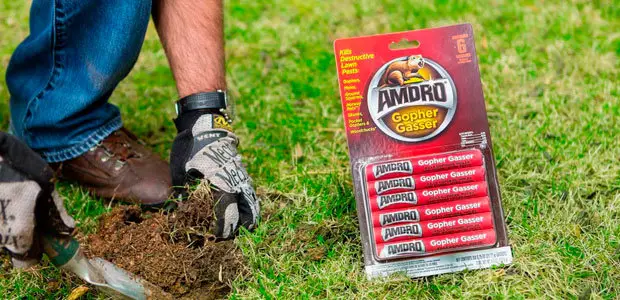
Gas Cartridges
- Smoke-producing devices that release toxic gases
- Insert directly into tunnels and seal entrance
- Most effective in moist, compact soils
- Less effective in sandy or dry soils
- Brand example: AMDRO Gopher Gasser
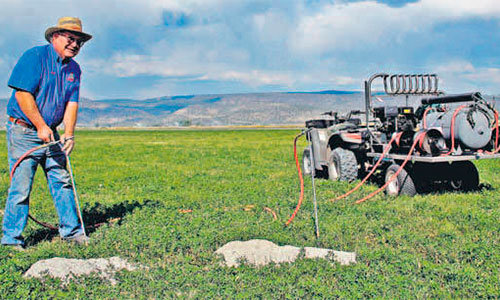
Carbon Monoxide Devices
- Machines that pump CO into tunnel systems
- Causes rapid unconsciousness followed by death
- No chemical residue in soil
- Can be effective for large tunnel systems
- Requires specialized equipment
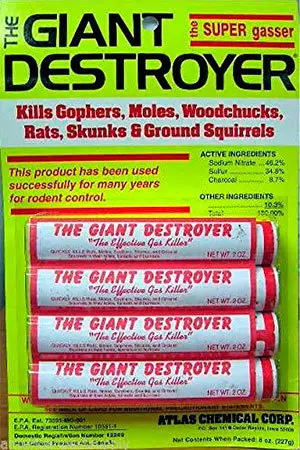
Gas Explosion Devices
- Pump propane/oxygen mixture into tunnels
- Ignite to create controlled underground explosion
- Quick elimination and tunnel collapse
- Can damage nearby infrastructure
- Significant safety considerations
Fumigation and gas methods pose significant safety risks if not handled properly. Never use homemade devices or automotive exhaust, which can lead to fire hazards, explosion risks, or exposure to dangerous fumes. These methods should never be used near buildings, utility lines, or dry vegetation. Always follow manufacturer instructions precisely and consider professional application for these more intensive control methods.
Application Guidelines
| Step | Gas Cartridges | Carbon Monoxide Devices |
|---|---|---|
| Preparation |
|
|
| Application |
|
|
| Follow-up |
|
|
Control Strategy 5: Baiting with Rodenticides
Rodenticides should be considered a last resort when other methods have failed or when dealing with severe, widespread infestations. These products contain toxic substances that can pose risks to non-target wildlife, pets, and the environment if not used properly.
Rodenticides can harm children, pets, and wildlife if not used properly. Always read and follow all label instructions. Store all baits in original containers out of reach of children and pets. Dispose of dead gophers properly to prevent secondary poisoning of predators or scavengers. Check local regulations before using any rodenticide, as some products may be restricted in certain areas.
| Bait Type | Active Ingredient | How It Works | Application Method |
|---|---|---|---|
| Grain Baits | Zinc phosphide, Strychnine | Acute toxicants that work quickly, usually within 24 hours | Place 1-2 tablespoons directly into main tunnel |
| Pellet Baits | Diphacinone, Chlorophacinone | Anticoagulants that prevent blood clotting, work over 5-7 days | Place in main tunnel using a bait dispenser probe |
| Block Baits | Diphacinone, Bromadiolone | Weather-resistant anticoagulants, effective in moist conditions | Place 1-2 blocks deep into main tunnel system |
| Liquid Baits | Various (often mixed with attractants) | Combined with food attractants for enhanced consumption | Applied with specialized applicator into tunnel system |
Proper Bait Application
Step 1: Locate Active Tunnels
As with trapping, identify fresh mounds and use a probe to locate the main tunnel. The main tunnel is typically 8-12 inches away from the plug side of a fresh mound and usually 6-12 inches below the surface. When the probe drops suddenly, you’ve found the tunnel.
Step 2: Create Access
Using the probe hole or by carefully digging, create an opening to the main tunnel. Make it just large enough to insert bait, but not so large that excessive light enters the system or the tunnel structure is compromised. Wear gloves to protect your hands and prevent human scent transfer.
Step 3: Apply Bait Properly
Following product instructions precisely, place the recommended amount of bait (typically 1-2 tablespoons of grain bait or 1-2 blocks) into the main tunnel. Some products include specialized applicators. Place bait in both directions of the main tunnel when possible.
Step 4: Seal the Opening
Close the opening with a rock, piece of sod, or soil clod to exclude light but avoid pushing soil into the bait. Complete darkness in the tunnel is crucial for bait acceptance, as gophers will otherwise plug the area with soil, potentially covering the bait.
Step 5: Mark and Monitor
Mark baited locations with flags for follow-up monitoring. Check for new mound activity after 48-72 hours. If new mounds appear, reapply bait following the same procedure. Systematic application throughout the property may be necessary for complete control.
Step 6: Prevent Secondary Poisoning
Regularly check for and properly dispose of any dead gophers found above ground. This reduces the risk of secondary poisoning to predators, pets, or scavengers. Follow local regulations for proper disposal methods.
For more detailed information on gopher baiting and poison options, see our comprehensive guide on gopher poison.
Professional Gopher Control Services
For severe infestations, properties with extensive damage, or situations where DIY methods haven’t been successful, professional pest control services offer expertise, specialized equipment, and access to restricted control products.
When to Consider Professional Help
- Large-scale infestations covering multiple acres
- Failed DIY attempts despite consistent efforts
- Property damage concerns to structures or valuable landscaping
- Limited time or physical ability to implement control methods
- Need for guaranteed results with ongoing maintenance plans
| Service Type | What’s Included | Typical Cost Range |
|---|---|---|
| One-Time Treatment |
|
$150-$500 depending on property size |
| Comprehensive Program |
|
$300-$1,000+ with monthly maintenance options |
| Agricultural/Large Property |
|
$500-$3,000+ depending on acreage |
When hiring a pest control service, verify their licensing and insurance. Ask about their specific experience with gopher control, what methods they use, and whether they offer guarantees. Request references from previous clients with similar gopher problems. Reputable professionals will provide a written estimate and treatment plan before beginning work.
Creating an Integrated Gopher Management Plan
The most effective long-term approach to gopher control combines multiple strategies in a comprehensive management plan. This integrated approach addresses both immediate control needs and prevention of future infestations.
| Time Frame | Management Actions | Goals |
|---|---|---|
| Immediate (1-2 weeks) |
|
Reduce active gopher population and halt ongoing damage |
| Short-term (1-3 months) |
|
Secure protected zones and prevent recolonization |
| Long-term (Ongoing) |
|
Create an environment that naturally deters gopher settlement |
Timing your gopher control efforts with their natural behavior cycle can improve results. Spring is ideal for intensive control as gophers are actively breeding and creating new tunnels. Fall is another high-activity period as gophers prepare for winter. Summer control can be challenging as gophers may move deeper due to dry soil conditions. Winter action targets overwintering populations when their activity is more concentrated.
Frequently Asked Questions
How can I tell if I have gophers or moles?
Gophers create crescent or fan-shaped mounds with a plugged entrance on one side. The soil appears finely sifted and the mounds typically form a line as tunnels extend. Gophers primarily damage plants by eating roots.
Moles create volcano-shaped, conical mounds with the entrance hole in the center. They also create raised ridges across lawns from their surface tunnels. Moles primarily eat insects and grubs, causing less direct plant damage but significant soil disruption.
How quickly can gophers damage my yard?
A single gopher can create 10-30 mounds per month and can excavate several hundred pounds of soil annually. They can consume their body weight in vegetation daily, potentially killing young trees or plants within days by severing roots. Multiple gophers can quickly transform a well-maintained landscape into a network of mounds and tunnels within weeks.
Are there any humane ways to remove gophers?
Yes, several humane approaches exist. Exclusion methods like underground fencing and plant baskets prevent access without harming gophers. Natural repellents including castor oil, plant-based deterrents, and sensory devices can encourage gophers to relocate. Live trapping is another option, though check local regulations regarding relocation of captured animals.
Will gophers eventually leave on their own?
It’s unlikely that gophers will leave established territories without intervention. As herbivores with modest range requirements, gophers have little incentive to abandon an area with adequate food and suitable soil. Seasonal shifts in activity may occur, but this typically represents changed burrowing depths rather than abandonment. Control measures are usually necessary to resolve established infestations.
Do over-the-counter repellents really work?
Commercial repellents show mixed results. Castor oil-based products have demonstrated some effectiveness in university studies, while ultrasonic devices have generally proven less reliable. Effectiveness depends on proper application, infestation severity, and environmental conditions. Repellents work best as part of a comprehensive approach rather than as standalone solutions, and they’re most effective for prevention rather than eliminating established populations.
How deep do I need to bury fencing to keep gophers out?
For effective gopher exclusion, bury hardware cloth at least 18-24 inches deep. The bottom 6 inches should be bent outward at a 90-degree angle away from the protected area to prevent gophers from digging under the barrier. The fence should also extend 4-6 inches above ground to prevent gophers from climbing over. Use hardware cloth with openings no larger than 1/2 inch.
How to Get Rid of Gophers: Conclusion
Dealing with gophers requires understanding their behavior and implementing appropriate control strategies based on your specific situation. By following a progressive approach—starting with prevention and exclusion before moving to more intensive methods—you can effectively manage gopher problems while minimizing environmental impact.
For successful gopher management: (1) Correctly identify the pest through their distinctive mounds and damage patterns; (2) Implement a combination of control methods rather than relying on a single approach; (3) Address the entire property to prevent reinfestation from adjacent areas; (4) Maintain vigilance through regular monitoring even after control seems successful; and (5) Consider the specific characteristics of your property and the season when selecting control methods.
Whether you choose natural deterrents, physical barriers, trapping, or professional services, consistency and persistence are key to reclaiming your yard from gophers. Remember that complete elimination may not be realistic in areas with high gopher populations, but with proper management, you can significantly reduce their impact and maintain a beautiful, healthy landscape.
